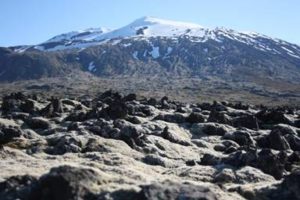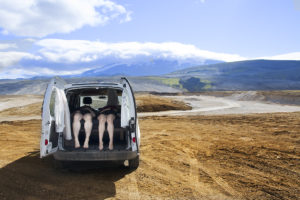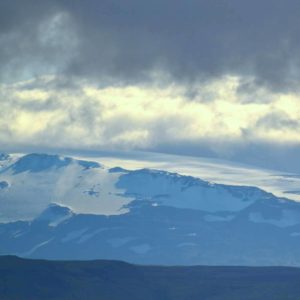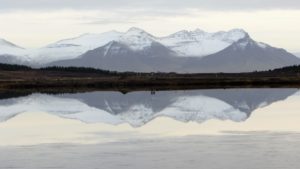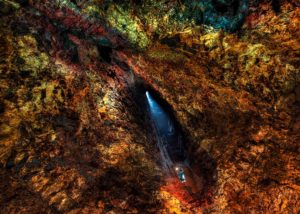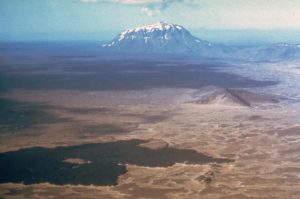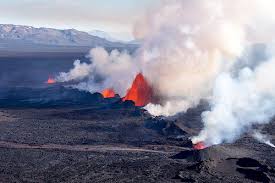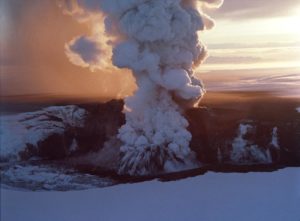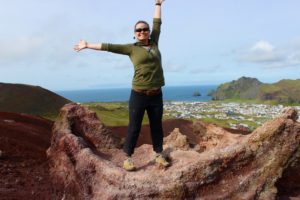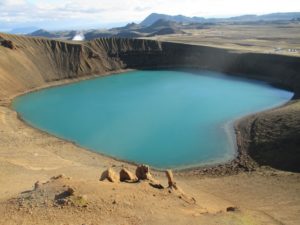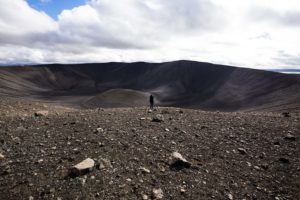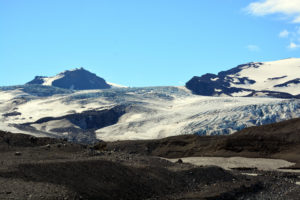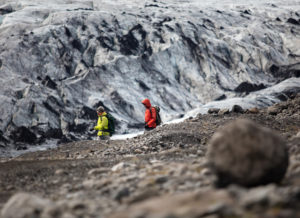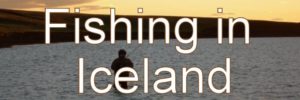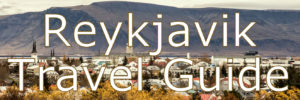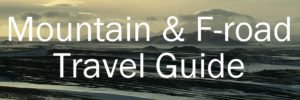Volcanoes in Iceland
The word volcano is often synonym for death, destruction, and mayhem. True, volcanoes around the world has been one of the big natural causes for millions of deaths, famine and destruction. For example, a lesser known fact. When the Laki volcanic fissure in southern Iceland erupted over an 8 month period from 8 June 1783 to February 1784, spewing lava and poisonous gases that devastated the island’s agriculture, killing much of the livestock. It is estimated that perhaps a quarter of Iceland’s population died through the ensuing famine. The dust and haze that followed in the northern hemisphere caused ships to be stuck in harbors and crops were failing. The Laki eruption sparked the French revolution!!! The British naturalist Gilbert White described the European scene:
“The sun, at noon, looked as blank as a clouded moon, and shed a rust-
coloured ferruginous light on the ground, and floors of rooms; but was
particularly lurid and blood-coloured at rising and setting. At the same time
the heat was so intense that butchers’ meat could hardly be eaten on the day
after it was killed; and the flies swarmed so in the lanes and hedges that they
rendered the horses half frantic … the country people began to look with a
superstitious awe, at the red, louring aspect of the sun.”
The eruption also disrupted weather pattern all over the world. Winters became much more harsh than usual and the monsoon cycle in Asia changed pattern. Scientists believe the eruption affected the world for well over two years.

Lets not forget the power of Eyjafjallajökull when it effectively stopped all air traffic in Europe but these incidents are the rare extremes. Iceland has about 130 volcanoes but only 18 of them has erupted in modern history and with only very few ones that erupt regularly with Hekla, Grímsvötn and Katla erupting most frequently.
While volcanoes are dormant (even fully active), they are fascination and draws crowds all over the world and so in Iceland too. To help you find your way around the Icelandic volcanoes, we have made this volcano guide for you.
Eyjafjallajökull
Last eruption: 2010
After the 2010 eruption, this might be the world’s best known volcano. Not only because it stopped air traffic but also because news media all around the world failed utterly to try to pronounce the name of the volcano.
Eyjafjallajökull reaches a height of 1666m (1.03 miles). It is not safe to hike on the volcano despite it’s covered by an ice cap but one gets a pretty good look at it when hiking the Fimmvörðuháls ridge trail.
Location: Eyjafjallajökull is in south Iceland and a great viewing point can easily be reached in a rental car (see map). Coming from the west, you’ll reach Hvolsvöllur. Instead of continuing on the Ring road, take a left on to road 261 and drive about 26km/16.2 miles. You will arrive to a parking lot, giving you a view of the volcano.
Snæfellsjökull
Last eruption: 200 AD ±150 years
This volcano is the most famous one in the literal world as it was thought to be the entrance to the center of the world in 1864 Jules Verne’s book “Journey to the Center of the Earth”. The last time Snæfellsjökull erupted was “back in the day”, around 200 AD, give or take a hundred years. It’s 1446m/0.9 miles top has always been covered in ice in modern times but in August 2012, the top of the volcano was ice free for the first time in recorded history.
The volcano/glacier has many fantastic hikes but as always when going hiking, find out how the conditions are and what the weather will be like. Well up on the top, you are rewarded (weather permitting) with the most stunning views in all directions.
Location: It’s a 184km/114.2 miles from Reykjavik to the road leading up to Snæfellsjökull. The road condition varies between years and many times, ordinary cars can’t drive up here so find out how far you can drive in your vehicle before driving up.
Hekla
Last eruption: 2000
Hekla is one of the most active volcanoes in Iceland. The last eruption was in 2000 (it was predicted 15 minutes before that it would erupt) and its eruptions have often been very big and violent but in the last few hundred years, they have decreased in power and violence. For many years Hekla was thought to be the gateway to hell but that theory was disproved when two scientists hiked up to the top back in 1750.
It’s 1491m/0.92 miles high and is a very popular location for hikers. Before going on a hike on Hekla (at your discretion), visit the Hekla center (see map) to get all the latest news. They will also have information about where to park, trails and whatever you need for a day on the volcano.
Location: It’s a 110km/63.4 miles drive to the center from Reykjavik where you will get all the information you need.
Öræfajökull – Vatnajökull
Last eruption: 1727
This volcano is under Europe’s biggest glacier with the highest peak, Hvannadalshnjúkur at 2110m/1.3 miles. It is also the biggest active volcano in Iceland but it hasn’t been that active, actually, only twice in the last 800 years. 1362 and 1728. There has been some increased activity but with these numbers it will erupt in 2200 next time.
There are many different organised activities to choose from on Vatnajökull like hiking, snowmobiling or super jeep tours.
Location: Depending on where you will mount the glacier but most people camp or stay in huts south of the glacier (Marked as a tent on the map above). It’s 390km/242.3 miles between Reykjavik and the campsite in Vatnajökull national park.
Katla
Last eruption: 1918
Another volcano hidden (until it erupts) under a glacier. Katla lies dormant under Mýrdalsjökull glacier. When Katla erupts (last in 2011), there will be massive floods of glacier water in its wake. Or to repeat the famous words of our former president: “You haven’t seen nothing yet”. Katla erupts in intervals of 13–95 years but it hasn’t erupted violently in hundred years so we are waiting for the big one. The quote is referring to a very infamous speech the ex president of Iceland made when Eyjafjallajökull erupted, referring to Katla.
The 10km/3.9 mile caldera is mostly covered with the Mýrdalsjökull glacier and is between 200m to 700m (656 to 2297 ft) thick.
Location: As Katla is well below the ice, there are numerous tours to choose from. Most of them depart from in and around Vík in Mýrdal. Katla itself isjust north of Vík.
Þríhnjúkagígur
Last eruption: 2 BC
This is the only volcano you can enter as it has been dormant since the second century BC. Now you can go on a tour to the bottom of the 213 meters (699 ft) deep Magma chamber.
In 2015, the Icelandic rock band Kaleo went down to the bottom of the volcano to record the music video to the tune “Way down we go“.
Location: You’ll find this volcano almost straight south of Reykjavik. We do recommend you take one of the organized tours to the bottom as that is the only way to explore the depths of Þríhnjúkagígur.
Askja
Last eruption: 1961
This volcano was virtually unknown until a massive eruption in 1875 when ash killed livestock, poisoned the soil in East Iceland and traveled all the way to northern Europe.
This place is a popular destination for Icelanders but driving there requires big SUV’s and is only accessible in high summer and it’s only F-roads up there..
Location: Askja lies in the central part of the highlands and lies north of Vatnajökull glacier.
Bárðarbunga
Last eruption:2015
When Bárðarbunga in Holuhraun erupted in 2015, it created what is called here as a Tourist eruption. People from all over the world came here to see it erupt. The volcano did release dangerous gasses but those gasses were only hazardous if you were close to the eruption.. The only way to visit Bárðarbunga is by helicopter or by a Superjeep tour.
Location: Almost in the center of Iceland. Southwest of Askja.
Grímsvötn
Last eruption: 2011
A volcano deep under an ice cap and every time it erupts, it melts an incredible amount of water, flooding over the plans on the south side of Iceland. It’s in the same volcanic system as Laki (1783-84), the big one that caused famine, death & destruction. It is also the Laki eruption that ignited the French revolution (see above). Grímsvötn is one of the most active volcanoes in Iceland.
Location: Almost straight south from Bárðarbunga. Only accessible by Superjeeps or Helicopters.
Eldfell
Last eruption: 1973
This volcano on the Westman islands created havoc in 1973 when all the islanders were moved up on main land. It destroyed around 400 homes and threatened to close the harbor too. A huge effort was made to stop the flowing lava by spraying the lava with endless amount of seawater, to cool it and direct the flow elsewhere and it was a huge success. The whole eruption is very well documented in their museum on the island.
Location: It’s located on the east side of the island with a very easy access by a road. To reach Westman islands, you take a ferry from Landeyarhöfn.
Surtsey
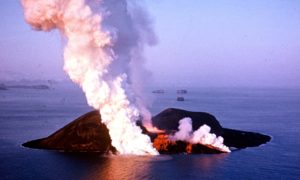
Last eruption: 1963
This eruption took place under the water and created a brand new island called Surtsey, the newest island in the world. The island is totally closed for tourists as they study the life on the island, only scientists are allowed there but there are boat trips around the island, leaving from Heimaey, Westman islands.
Location: 19km/11.8 miles southeast of Heimaey. Can be seen from Heimaey in good weather.
Krafla
Last eruption: 1984
There has been 29 eruptions at Krafla since recorded history. Now it’s a very popular tourist destination and thermal energy from the area is used to make power since 1977. For tourists there are 3 great destinations in the area. Leirbotn, power station, Víti, a volcanic crater lake with a turquoise color and Leirhnjúkur lava fields.
Location: About 16km/9.9 miles northeast of Reykjahlíð, the village by Lake Mývatn in North Iceland.
Hverfell – Hverfjall
Last eruption: 500BC
This is a dormant volcano that is fantastic to visit. There are two ways up on the crater and both ways are clearly marked. When of if you go for a hike there (highly recommended), remember to keep on the marked tracks at all times.
Location: Just south of Reykjahlíð, the village by Lake Mývatn in North Iceland.
Kverkfjöll
Last eruption: 1968
Another volcano hiding under the mighty Vatnajökull glacier. When any of the volcanoes hiding under a glacier erupts, it causes glacier runs, at times massive ones, sweeping everything in its path with to the ocean.
Again, due to its location, it is only possible to visit the place in a Superjeep tour or a helicopter ride or a snow mobile tour during winter.
Location: 38km/23.6 miles straight east from Bárðarbunga, well under the glacier Vatnajökull.
Torfajökull
Last eruption: 1477
The volcano got its name from a historical figure called Torfi. During the big plague in 1493, Torfi escaped with his family up to the highlands. He settles somewhere close to the volcano. When it erupted around 870, tephra covered the whole country and still can be found all over Iceland. This is also one of those very hard to reach places but there are many hike tours to choose from if you want to explore this gorgeous area.
Torfajökull is also believed to be one of the main causes for the existence of the divine area called Veiðivötn which we featured in our blog “Fishing in Iceland“.
Location: Straight north of Mýrdalsjökull

There are many more volcanoes in Iceland but many of them are just dormant and have no activity at all. Most volcanoes are not easily accessed and caution is required at all times. Before going on a hike or try to drive close to one, get local knowledge but remember, all off road driving is strictly forbidden and F-roads usually requires big 4×4 vehicles to pass safely.
When you are driving around in Iceland, do try to go on a tour to the volcanoes that allows it for it is a remarkable experience we are sure will be an unforgettable experience.
Safe travels! #GoIceland
